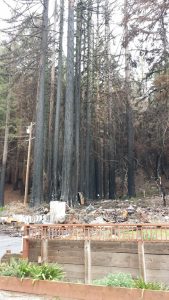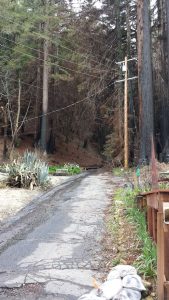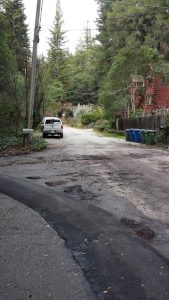I live in the mountains in a redwood forest in Central Coast California. I love this place and the deep serenity it has brought me. But there’s a down side to every locale, and wildfires are part of the ecology of this region. Much of the plant life, including redwoods, has evolved to survive and even thrive with periodic conflagrations. Humans, on the other hand, aren’t too fond of having their homes burned down, so they put out little fires, allow

underbrush to build up, and are loathe to control flammable invasive species (like broom). Increasingly long, hot, dry summers that are the result of climate change turns the region, like many in the West, into a tinderbox. Last summer’s freak lightning storm ignited thousands of small fires that merged into huge ones. I’ve written earlier about my experience being evacuated and watching, day by day, as fires engulfed this area but the heroic efforts of fire fighters spared my own street.
Almost as soon as the mandatory evacuation orders were lifted, local authorities began an campaign of education and preparation for the next phase of this rolling disaster: debris flows. Debris flows are a type of mudslides.
Debris flows … are fast-moving downslope flows of mud that may include rocks, vegetation, and other debris. These flows begin during intense rainfall as shallow landslides on steep slopes. The rapid movement and sudden arrival of debris flows pose a hazard to life and property during and immediately following the triggering rainfall.1
In other words, debris flows are rivers of cement 15 or more feet high and moving at up to 40 mph. If you can see it, it’s too late. There’s no way to prepare except to get out of the way. Debris flows caused massive property damage and over 20 fatalities in 2018 in Montecito, Southern California. Our local agencies were understandably concerned.
We all studied the maps of debris flow risk and watched the weather forecast. November and December passed with only occasional gentle showers, well belong the threshold for triggering a debris flow. Some of us began to relax, hoping for a dry “La Niña” year. Old timers warned that often the real rains don’t set in until January. They were right.
We watched the approaching storm in the extended weather forecast. It became apparent this was no shower but an atmospheric river, capable of parking itself over our region and dumping inches upon inches of rain.
Although

our side of the block wasn’t burned, the fire swept down the top of the ridge on the other side of the street, coming down to the street in places. Across from our carport, a small paved road rises in a V, the slopes of which were burned but have been hydroseeded. The redwood trees all survived, many with charred trunks but new growth from their roots and crowns. California oaks also fared well, and their deep tap roots are great for stabilizing hillsides. I concluded that our property would likely fare well, with muddy floors at worst, but that the streets at either end of our block were at risk of being closed and we’d be cut off. Okay, evacuation it is.
I’d already begun preparations by researching hotels (and concluding that despite the distance, it was cheaper and more comfortable for us to return to the extended-stay hotel where we stayed for 3 weeks last summer),
attempting to desensitize the cats to their carriers, using up food in the freestanding freezer (and replacing it with gallon milk jugs filled with water, so that if we lost power, the freezer would stay cold longer), and so forth. I placed the checklists I’d made last summer on the kitchen counter.
Although the sky was still blue, the county issued an evacuation warning while the storm was still a couple of days out. We watched as the atmospheric river headed our way. When the mandatory order came, giving us 24 hours before the storm was expected to hit, I called the hotel, reserved a suite, and we began packing. While I was loading my car, deputy sheriffs came by, going door to door. “Are you staying?” they asked. I pointed to the open trunk and suitcases therein. “On our way out.” “Good!” We learned later that they were asking anyone not planning on evacuating to sign a waiver. Some folks in my neighborhood didn’t leave. Eventually everyone on my block did, and we all kept tabs on one another through social media, as we did during the fires.
We settled into our hotel and waited. The atmospheric river curved south, pummeling our area but hitting hardest in Monterey County, particularly Big Sur, where it swept away a section of Highway 1. Still, those locals who stayed reported “a wild night” of high winds and downpours. Luckily, they didn’t lose power or internet. Everyone worried that the downpour would saturate the burn scars and then even a light rain might cause slippage or flows.
This didn’t happen.
We returned after the mandatory order was changed to a warning (which has still not been lifted), to find our house intact and no more than a bit of extra mud and debris from the tiny street. The asphalt berm we’d installed in back of the carport had done a splendid job of guiding the water into the culvert just north of us and away from our house.
Discussions ensued. Had the agencies been hasty in ordering the evacuation? Had it been truly necessary? So many of us were suffering now from evacuation exhaustion on top of pandemic fatigue. Given how

well our region fared, many questioned using the Montecito event as a model.
Those southern mountains are covered in chaparral, while ours are covered in redwood trees. The rocks are different, even the storms are different, Finnegan explained. There are many reasons why the current models don’t perfectly capture the dynamics of how debris flows will get started in the Santa Cruz Mountains.2
So here we are, having settled back in. The suitcases are unpacked, the cats once more in their familiar domicile, but in some ways things are less certain than before. We’d decided to obey an evacuation order. It turns out, we didn’t need to. How will we evaluate the next one, if it comes? Make a judgment about the storm ourselves? Look at how, if at all, the relevant agencies have shifted their protocols in response to this last storm? How to weigh the cost and exhaustion (not to mention lost school/work time and 4 irate cats) versus the perceived debris flow risk?
Stay tuned. Our neighbor is renting a backhoe to widen and deepen the culvert. Sandbag barriers are sprouting everywhere. We’ll see what the next months bring…
- https://www.slvwd.com/customer-resources/pages/post-fire-preparedness-resources
- https://lookout.co/santacruz/environment/story/2021-01-27/czu-burn-scar-debris-flow-risk-santa-cruz?fbclid=IwAR3K40fp5i-Q9APl-6T8qmqxUB3ViaDgglDSbUrhnHYOQsVmq9fYtiNHWC8

I’m so glad you evacuated, but even gladder that you came back and everything was OK. I’m impressed at the doorknocking. This happens in some places here, but not all, and isolated people (who live alone, have no car etc) can fall into trouble. I worry less when regions have good local checks and when my friends live in areas that keep track of each other.
Thanks, Gillian. Although my town is small — 5,000 folks, 4 blocks with no traffic lights and only one stop sign — it’s a tight-knit community. We’re all still reeling from the wildfires last summer, and taking extra care in looking out for one another. Handmade signs thanking fire fighters/first responders alternate with “CZU Fire Survivors, We Love You.” Our block and the adjacent streets formed a FB DM group to keep in touch last summer, and it’s still going strong.